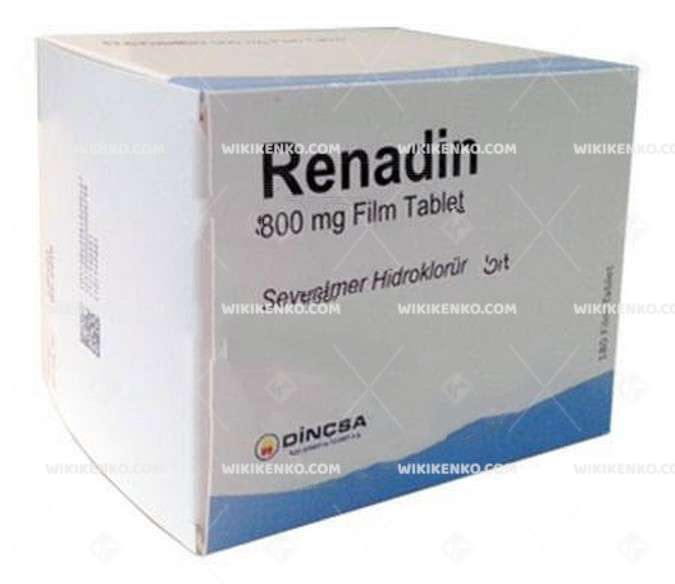Renadin Film Tablet
In the realm of medical solutions, Renadin emerges as a crucial tool in managing chronic kidney disease (CKD). This film tablet, fortified with the active ingredient sevelamer hydrochloride, plays a pivotal role in controlling serum phosphorus levels among adult patients undergoing dialysis. Our exploration delves into its composition, recommended dosages, precautions, and potential interactions, shedding light on the nuances of this pharmaceutical marvel.
| Dosage form | |
|---|---|
| Pack size | |
| Potency | 800 Mg |
| Manufacturer | |
| Origin | |
| Generic Name (Ingredient) | Each Film Tablet Contains 800 Mg Sevelamer Hydrochloride. |
Assuming your emergency circumstances for this product, visit Urgent Quotation page. Besides, for any pharmaceutical questions, please ask us in the comments section.
Description
Renadin Ingredients
At its core, Renadin contains the potent sevelamer hydrochloride as its active ingredient. However, it’s not a solo act. Renadin’s formulation includes several excipients, which contribute to its effectiveness. These components encompass the tablet core and the film coating:
Tablet Core Ingredients:
- Colloidal Silicon Dioxide
- Stearic Acid
- Talc
- Microcrystalline Cellulose
Film Coating Ingredients:
- Opadry II Clear (Polysorbate 80, Talc, Polyvinyl Alcohol, Polyethylene Glycol/Macrogol)
- Opadry FX (Mica-based Pearlescent Pigment, Talc, Polyethylene Glycol/Macrogol, Polyvinyl Alcohol, Polysorbate 80)
These excipients are instrumental in shaping the tablet and ensuring the efficient delivery of sevelamer hydrochloride.
Indications for Renadin Film Tablet
Renadin assumes a crucial role in the realm of CKD management. It is specifically indicated for the control of serum phosphorus levels in adult patients with chronic kidney disease who are undergoing dialysis. Additionally, Renadin may be employed in conjunction with calcium supplements and vitamin D analogs to curb the development of renal bone disease. This dual functionality underscores its significance in comprehensive CKD care.
Dosage
The correct administration of Renadin hinges on several factors, including serum phosphorus levels. The recommended starting dose varies accordingly:
- For patients with serum phosphorus levels between 1.76-2.42 mmol/L (5.5-7.5 mg/dL), the suggested initiation comprises one film tablet taken three times daily with meals.
- For patients with serum phosphorus levels surpassing 2.42 mmol/L (>7.5 mg/dL), the preferred commencement involves two film tablets taken three times daily with meals.
The dosage may undergo adjustments, aiming to achieve a target level of 1.76 mmol/L (5.5 mg/dL) or lower. These adjustments can encompass increments or decrements of one tablet per meal at two-week intervals, tailored to individual requirements.
Precautions
While Renadin is an invaluable asset in CKD management, certain precautions should be diligently observed:
- Patient Suitability: It is not suitable for patients with low serum phosphate levels, bowel obstruction, or known hypersensitivity to sevelamer hydrochloride or any of its excipients.
- Cautionary Use: Caution should be exercised when prescribing Renadin to patients with swallowing difficulties, gastrointestinal motility disorders, gastric retention, active inflammatory bowel disease, or a history of major gastrointestinal surgery.
Interaction with Other Medications
Renadin may interact with other medications or dietary elements, potentially influencing their effectiveness or causing unexpected side effects. Patients are advised to disclose their full medication and supplement regimen to their healthcare provider before initiating treatment with it. This practice ensures that any potential interactions are identified and managed effectively.
Conclusion
In the complex landscape of CKD management, Renadin film tablets, enriched with sevelamer hydrochloride, stand as a formidable ally in controlling serum phosphorus levels. Their role extends beyond the immediate, encompassing the prevention of renal bone disease. However, the correct utilization necessitates a nuanced approach, with dosages tailored to individual needs and prudent precautions exercised.
This overview of Renadin serves as an informed introduction to its application. For personalized guidance and a comprehensive understanding of its implications on your health, it is imperative to engage in a detailed discussion with your healthcare provider. Its contribution to enhancing the lives of CKD patients underscores the continued progress in the field of modern medicine.
Use the form below to report an error
Please answer the questions as thoroughly and accurately as possible. Your answers will help us better understand what kind of mistakes happen, why and where they happen, and in the end the purpose is to build a better archive to guide researchers and professionals around the world.
The information on this page is not intended to be a substitute for professional medical advice, diagnosis, or treatment. always seek the advice for your physician or another qualified health provider with any questions you may have regarding a medical condition. Always remember to
- Ask your own doctor for medical advice.
- Names, brands, and dosage may differ between countries.
- When not feeling well, or experiencing side effects always contact your own doctor.
Cyberchondria
The truth is that when we’re sick, or worried about getting sick, the internet won’t help.
According to Wikipedia, cyberchondria is a mental disorder consisting in the desire to independently make a diagnosis based on the symptoms of diseases described on Internet sites.
Why you can't look for symptoms on the Internet
If diagnoses could be made simply from a textbook or an article on a website, we would all be doctors and treat ourselves. Nothing can replace the experience and knowledge of specially trained people. As in any field, in medicine there are unscrupulous specialists, differences of opinion, inaccurate diagnoses and incorrect test results.



Reviews
There are no reviews yet.